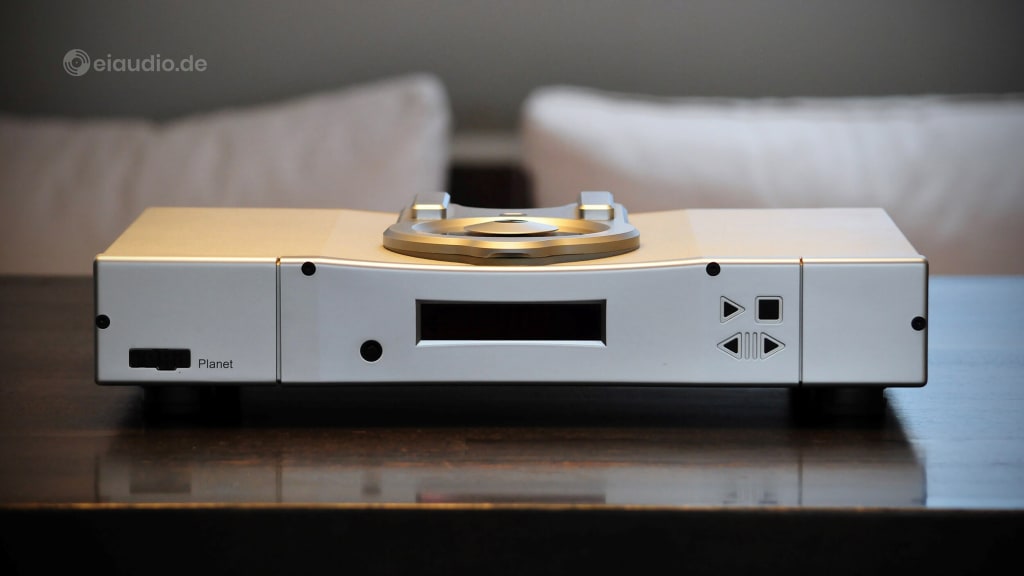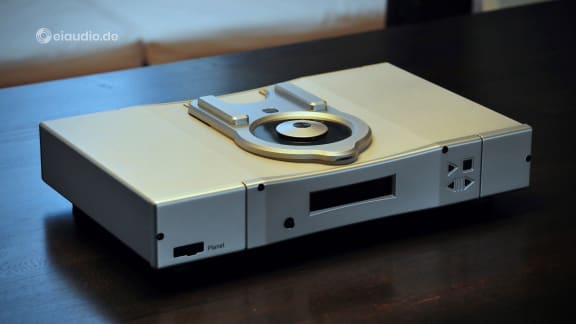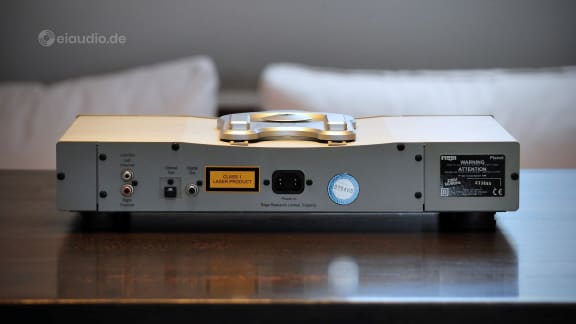Rega Planet 2000
Published: 10/03/2021
Manufacturing date: 2000
Author: Karsten Hein
Category: Gear & Review
Tag(s): CD-Players
It is sometimes suggested that the CD today is an outdated medium, and that its prescribed 16-bit, 44.1 kHz Red Book standard places it well below the musical abilities of other analog and digital devices. This is no wonder, of course, as today’s audiophile competition comes in form of high-resolution formats from digital streaming services and from the analog revival that, after decades of stagnation, has once again led to rising vinyl sales. In addition to this, the CD is sidelined by audio formats of lesser significance, such as Super-Audio CDs, DVD-Audio, reel-to-reel, etc.
And yet, the medium has a lot going for itself. For one thing, it is tangible. Touch is something that a subscription to Tidal or Amazon HD is sorely lacking. While it is true that many CDs are sitting on our shelves never to be heard again, there are currently around ten CDs in our home collection—mostly Jazz and vocal Jazz albums—that are getting all the attention they could ever ask for. And then there is the pride of ownership, of course, as the hunter-gatherer in me is enjoying the fruits of said labor. And—since the laser does not physically touch the track while reading—there is no immediate worry about deterioration either. In obvious contrast to vinyl, CDs do not suffer as much from the effects of repeat play.
Similar to records, audiophile CD players read the information straight from the disk and shy away from unnecessary storage or modulation of sound. They will expose the shortcomings of both the medium and the recording, important factors in providing a reassuring sense of realism and dimension. In contrast to vinyl, however, the CD itself does not contribute its own material resonances that would make it sound organic and therefore familiar to the human ear. Instead, CD data is likely to be affected by resonances emanating from the drive motor, the laser’s queuing mechanism, vibrations from the built-in transformer, and from other units in the rack. It can be said that all electronics and mechanics around the music information on a CD are larger, louder, and prepared to spoil the listening fun. And since the resulting effects are unfamiliar to the human ear, they can be deemed unpleasant. Still, the CDs biggest sonic advantages over modern streaming services are that it is both tangible and local. Its data stream does not depend on the integrity of various relay servers along the way to reaching our ears.
The first Rega Plant CD player came out in 1997, a time when the CD was at the height of its popularity, and four long years before the first mp3 players came to the market. Rega was already a familiar brand in the audiophile community. Founded in 1973, the British ‘Rega Research Ltd.’ had been known as a notable manufacturer of audiophile amplifiers, loudspeakers, and—most significantly—turntables long before they ever considered making a CD player. The famously affordable Planar 3 turntable had won Rega international recognition among vinyl enthusiasts and become a bedrock for analog playback. In addition to selling under their own brand name, Rega had also been asked to supply turntables, tonearms, and related parts to other brands, such as NAD and Rotel.
For a vinyl specialist to enter the CD player market, the company needed to come up with a convincing argument for its followers. The original Planet was marketed as offering true ‘vinyl-like’ sound made by a company that normally hated the sound of CD players. This created some curiosity, and the original Planet sold well, despite its quirky industrial look. It favoured musical flow over detail and achieved a soft top-end despite sounding a bit bland and crude, as some reviewers of the player have observed. Especially the lack of detail on the Rega's customised Burr Brown 16-bit DAC has sometimes been criticised as being outdated in more recent reviews.
The Planet 2000 brought about a major facelift to the original Planet. Instead of plastic, it is housed in a custom-built extruded aluminium case with a central top-loading lid. The 2000 uses similar circuit topology as the original Planet but features an improved DAC (Wolfson 24-bit, Sigma Delta IC40), power supply and coupling capacitors. Instead of a conventional iron core transformer, the 2000 version has a toroidal transformer with separate windings for the display and audio stages. Display and controls were also given a makeover, giving the Planet 2000 a better performance, look, and feel in comparison with its predecessor. However, while many things have been improved, the player does have some surprising quirks that make it difficult to compare the Rega design with more conventional front-loading players.
For one thing, the top-loading mechanism means that the Rega 2000 requires at least 20cm of rack space height for the lid to fully open. Due to some necessary adjustments made for the Rega, my rack only offers 17cm which makes changing CDs less than convenient. The drive itself sits in a plastic tray at the centre of the player’s aluminium case. Where it has not been painted, the plastic has become tobacco-coloured from UV radiation on one side. Both the front and rear panel are made of plastic. While the front panel has been painted in cabinet colour, the rear has been left unpainted and also shows discolouration. Although we hardly come in contact with the front or the back of the player during operation, the use of plastic on the front has proven to be somewhat disappointing.
The Planet’s CD drive holds the CD in a peculiar way. Similar to a turntable, there is a central prong surrounded by a cone-shaped centre that is sitting on a spring. The CD is placed on the cone and continues to wobble. Pushing the lid down then lowers a magnet onto the centre of the CD and pushes down the cone with the CD exactly centred, or at least this is the theory. In reality, CDs are sometimes slightly off axis, resulting in a wobble of the disk and the magnet on top. And since the top of the magnet is visible though the lid from the outside, one cannot help but wonder how long this will continue to go on well. While the Rega’s custom made Sony transport is surprisingly resilient in reading despite disk wobble, it is at times possible to hear the wobble in the music though strangely elongated, followed by compressed, passages. When the disk does skip, the jump is quite brutal and can misplace the laser by as much as half a song. To be fair, most CDs play with only a tiny amount of wobble, and of those that exhibit wobble, side effects will be minimal. But the player is far less forgiving than any CD player I have ever had. Playing a CD becomes as delicate a ritual as playing a vinyl record.
Due to the excessive weight of the magnet, the Planet 2000 is quite demanding in terms of proper placement in the rack. The drive is in the centre of the extruded aluminium case that channels vibrations along its curved sides down to the four rubber feet. In contrast to our other CD players, the Rega requires just the right amount of support to keep it still. My first attempt was to place it in our rack without the support a base, but this made the player sound harsh and agitated. I then brought in a base placed on Oehlbach spiked absorbers. The player sounded soft but exhibited serious timing issues that made me look for the quirks rather than listen to the music. I swapped the absorbers for Harder Oehlbach pucks which helped to improve timing but somehow resulted in a lack of bass. I finally placed the base directly on the rack and was surprised that this by far sounded the best.
I love the fact that the Planet 2000 allows us to connect a dedicated power cord. Sadly though, the central position of the socket makes it more challenging to avoid the touching of cables behind the rack, especially, since dedicated cords, such as Lapp Ölflex are quite stiff. Turning the player on and off is possible while preamp and power amplifier are turned on without any trace of popping. This excellent muting of the player during operational changes is definitely noteworthy and very practical. SPDIF, Toslink, and RCA/cinch sockets are available to allow for all kind of applications, however, the plugs are slightly recessed into the rear panel, which might render them inconvenient in combination with some types of plugs. They could also feel a little sturdier, perhaps. Although the display has its own source of energy from the toroidal transformer, the sonic effects of having the display switched on are still audible in a slightly compressed and hazy soundstage. The display-off function allows the display to be turned off during playback with a positive effect on the sound. And since one can hear the difference, with a system and ears so inclined, it makes sense to use the display-off feature. When this function is engaged, however, the display will only light up briefly to acknowledge remote commands. While this is quite convenient, the on-time is a little too short for me to read the title. The display itself is red and relatively dark when turned on. This makes it difficult to read over long distances.
For optimum performance, the Planet 2000 needs to be paired with an excellent interconnect. In my experience, simple copper cables will not be able to show its full potential and could be a reason for some private reviewers reporting a lack of detail. I have tested the player with different types of RCE/cinch-type interconnects, from solid core copper, via silver coated multi-stand copper, to solid core silver, and I can report that the ladder surpassed all other choices by far. Using the silver solid core HBS2, the 2000 is sufficiently forward sounding and creates a wide open sound stage with an broad and accurate phantom centre image. I have no complaints about the amount of detail. If a disc should wobble, this can be heard mostly through timing issues and alternating channel imbalances.
If the recording permits, the Planet 2000 offers a smooth flow of music with a refined top-end. It is not quite as lush as the Philips CD 104 (NOS mod.) player, nor does it bring the music forward with such ferocity. It does, however, offer sufficient bass if properly placed on the rack. The music it produces is tonality accurate on piano, voice, percussion. The overall impression is laid-back with a sufficient amount of entertainment to keep me interested during longer listening sessions.
The biggest downside to the Rega Planet 2000 appears to be the magnet that holds down the disc. Rega have physically decoupled the toroidal transformer from the main board and the CD transport. They have asked Sony to aid them in the development of a unique transport mechanism, and yet, a wobbly magnet brings a new uncertainty into the equation. Since the whole CD transport can be replaced in the form of a low-cost kit that is screwed under the loading mechanism, I will attempt to fix the issue with a new drive. But if the magnet itself is to blame for the wobble, this matter will need further attention. All said, attempting to fully restore the Planet 2000 is a worthwhile activity, as the player itself performs far better than the typical mid-priced CD player found on the market today. In keeping with the tradition of other British audio brands, this player offers a gutsy and unique design approach that merits further exploration and therefore fits well with our website motto.
Specifications
- Laser type: semiconductor
- Wavelength: 780nm
- Transport: Sony, top-loading
- DAC: Wolfson, 24-bit Sigma Delta IC40
- Filtering: 3-stage linear FIR, 16x oversampling
- Connections: line (unbalanced), S/PDIF (coaxial), Toslink
- Line output (max.): 2V
- Output impedance: 930 ohms
- Digital output: 0.5V
- Load impedance (min.): 75 Ohms
- Power consumption (max.): 10 Watts
- Formats: CD, CD-R, MP3, WMA, WAV, AIFF
- Extras: 'Solar Wind' remote control, CD text display
- Dimensions: 43.5cm (w) x 10.0cm (h) x 27.0cm (d)
- Required Space: 43.5cm (w) x 18.0cm (h) x 31.5cm (d)
- Weight: 3.65kg
- Year: 2000





